
by Deep Green Resistance News Service | Jul 13, 2018 | Defensive Violence
Featured image by Souparno Chatterjee
by Chandan Sarma / Youth Ki Awaaz
Hakim Sinan village, Ranibandh Block, Bankura District, West Bengal:
It was getting dark in the forest. At a distance, light was gleaming from oil lamps in the village.
“Did you breastfeed these Saal trees? Why are you stopping us from cutting them down?” growled the poachers.
“How can you breastfeed your own mother?” retorted the resolute Adivasi women.
Culturally, forests have played a vital role in the lives of the Santhal tribes. This is much more evident in villages that live on the fringes of the forests. It is a relationship built on reverence and compassion.
Forests provide the tribes with fuelwood, leaves, herbs, fruits and honey. It is also the abode of many Gods and Goddesses. In fact, Santhals are proudly the forest people. The isolated Hakim Sinan village in Bankura district of West Bengal is an embodiment of this relationship of tribal communities with the forest. For Adivasi women, this bond is even stronger; the forest nurtures the community like a mother.

Illegal logging in this forest village had always been a problem. There had been intermittent and uncoordinated protests by many in the community. Women in the village had raised the issue on their own when they would cross the timber mafia in the forests. But not a leaf moved.
When NGO PRADAN started organising the Santhal women of Hakim Sinan village into Self-Help Groups (SHG) some years back, it was their first close interaction with outsiders. Interestingly, no one in this village had ever been to a bank: let alone open a bank account. A savings and credit group was formed which helped the families save money periodically and supported them for their credit needs. But this is not a story of financial sustainability – it is a story of the transformation of women from this village into an unwavering collective who can stand for their rights and values they cherish. Even in the face of life-threatening danger.
As poor and vulnerable Adivasi women in this village were organised, they grew in strength and confidence. Unfortunately, during this period, unabated illegal logging exacerbated to the point that it threatened the very existence of their forest. The destruction of their culture and harmonious relationship with Mother Nature stared at them. Moved by this destruction, this unified group of women decided to take a stand. But they were up against men with arms and influence. All they had were mere sickles and sticks and an insurmountable belief in their own collective strength.

When the women in one of their group meetings announced that they would now take turns to guard the forest every night, the rest of the village was bewildered. ‘How will these frail women take on the poachers?’
So, it began: the women grouped themselves and every night, one group would vigil the forests. Simultaneously, they lodged a complaint at the forest department.
The Nights Of Skirmish
On a moonlit night, one group of ‘guarding women’ came face to face with the poachers. One woman ran back to the village. An altercation ensued. A knife was put to the throat of Lokkhimuni Soren. The mighty were ready to shed blood. In the meantime, the rest of the women dashed to the forest. This group of 15 women was not backing down. The poachers threatened to come back with greater force.

On another night of skirmish, the poachers growled, “Did you breastfeed these saal trees? Why are you stopping us from cutting them down? Who are you to stop us?”
“How can you breastfeed your own mother? This forest is our mother and we will give our lives but will not let you cut the trees,” they retorted.
The poachers had to go back empty-handed again. More skirmishes followed but they halted the devastation of their forest.

The news of Adivasi women standing up to powerful poachers spread like forest fire. The women also repeatedly engaged with the Forest Ranger. An official meeting was arranged between them and forest officers. All poachers were subsequently arrested. Each one of them was fined ₹5,000. Illegal logging of trees in the vicinity of Hakim Sinan village and beyond has abated. There is still an undercurrent of threat to this collective from vested interests but the women of this SHG are confident of taking on any challenge to save their forest: their Goddess, their Mother.

Photo Credit: Souparno Chatterjee, PRADAN
Additional Inputs to the Story: Souparno Chatterjee; PRADAN Khatra Team, Bankura district, West Bengal.
Originally published on Youth Ki Awaaz. Republished with permission.
by Deep Green Resistance News Service | Jul 8, 2018 | Direct Action
Editor’s note: The following is from the chapter “A Taxonomy of Action” of the book Deep Green Resistance: A Strategy to Save the Planet. This book is now available for free online.
by Aric McBay
There are four basic ways to directly confront those in power. Three deal with land, property, or infrastructure, and one deals specifically with human beings. They include:
Obstruction and occupation;
Reclamation and expropriation;
Property and material destruction (threats or acts); and
Violence against humans (threats or acts)
In other words, in a physical confrontation, the resistance has three main options for any (nonhuman) target: block it, take it, or break it.
Let’s start with nondestructive obstruction or occupation—block it. This includes the blockade of a highway, a tree sit, a lockdown, or the occupation of a building. These acts prevent those in power from using or physically destroying the places in question. Provided you have enough dedicated people, these actions can be very effective.
But there are challenges. Any prolonged obstruction or occupation requires the same larger support structure as any direct action. If the target is important to those in power, they will retaliate. The more important the site, the stronger the response. In order to maintain the occupation, activists must be willing to fight off that response or suffer the consequences.
An example worth studying for many reasons is the Oka crisis of 1990. Mohawk land, including a burial ground, was taken by the town of Oka, Quebec, for—get ready—a golf course. The only deeper insult would have been a garbage dump. After months of legal protests and negotiations, the Mohawk barricaded the roads to keep the land from being destroyed. This defense of their land (“We are the pines,” one defender said) triggered a full-scale military response by the Canadian government. It also inspired acts of solidarity by other First Nations people, including a blockade of the Mercier Bridge. The bridge connects the Island of Montreal with the southern suburbs of the city—and it also runs through the Mohawk territory of Kahnawake. This was a fantastic use of a strategic resource. Enormous lines of traffic backed up, affecting the entire area for days.
At Kanehsatake, the Mohawk town near Oka, the standoff lasted a total of seventy-eight days. The police gave way to RCMP, who were then replaced by the army, complete with tanks, aircraft, and serious weapons. Every road into Oka was turned into a checkpoint. Within two weeks, there were food shortages.
Until your resistance group has participated in a siege or occupation, you may not appreciate that on top of strategy, training, and stalwart courage—a courage that the Mohawk have displayed for hundreds of years—you need basic supplies and a plan for getting more. If an army marches on its stomach, an occupation lasts as long as its stores. Getting food and supplies into Kanehsatake and then to the people behind the barricades was a constant struggle for the support workers, and gave the police and army plenty of opportunity to harass and humiliate resisters. With the whole world watching, the government couldn’t starve the Mohawk outright, but few indigenous groups engaged in land struggles are lucky enough to garner that level of media interest. Food wasn’t hard to collect: the Quebec Native Women’s Association started a food depot and donations poured in. But the supplies had to be arduously hauled through the woods to circumvent the checkpoints. Trucks of food were kept waiting for hours only to be turned away.31 Women were subjected to strip searches by male soldiers. At least one Mohawk man had a burning cigarette put out on his stomach, then dropped down the front of his pants.32 Human rights observers were harassed by both the police and by angry white mobs.33
The overwhelming threat of force eventually got the blockade on the bridge removed. At Kanehsatake, the army pushed the defenders to one building. Inside, thirteen men, sixteen women, and six children tried to withstand the weight of the Canadian military. No amount of spiritual strength or committed courage could have prevailed.
The siege ended when the defenders decided to disengage. In their history of the crisis, People of the Pines, Geoffrey York and Loreen Pindera write, “Their negotiating prospects were bleak, they were isolated and powerless, and their living conditions were increasingly stressful … tempers were flaring and arguments were breaking out. The psychological warfare and the constant noise of military helicopters had worn down their resistance.”34 Without the presence of the media, they could have been raped, hacked to pieces, gunned down, or incinerated to ash, things that routinely happen to indigenous people who fight back. The film Kanehsatake: 270 Years of Resistance documents how viciously they were treated when the military found the retreating group on the road.
One reason small guerilla groups are so effective against larger and better-equipped armies is because they can use their secrecy and mobility to choose when, where, and under what circumstances they fight their enemy. They only engage in it when they reasonably expect to win, and avoid combat the rest of the time. But by engaging in the tactic of obstruction or occupation a resistance group gives up mobility, allowing the enemy to attack when it is favorable to them and giving up the very thing that makes small guerilla groups so effective.
The people at Kanehsatake had no choice but to give up that mobility. They had to defend their land which was under imminent threat. The end was written into the beginning; even 1,000 well-armed warriors could not have held off the Canadian armed forces. The Mohawk should not have been in a position where they had no choice, and the blame here belongs to the white people who claim to be their allies. Why does the defense of the land always fall to the indigenous people? Why do we, with our privileges and resources, leave the dirty and dangerous work of real resistance to the poor and embattled? Some white people did step up, from international observers to local church folks. But the support needs to be overwhelming and it needs to come before a doomed battle is the only option. A Mohawk burial ground should never have been threatened with a golf course. Enough white people standing behind the legal efforts would have stopped this before it escalated into razor wire and strip searches. Oka was ultimately a failure of systematic solidarity.
Let’s start with nondestructive obstruction or occupation—block it. This includes the blockade of a highway, a tree sit, a lockdown, or the occupation of a building. These acts prevent those in power from using or physically destroying the places in question. Provided you have enough dedicated people, these actions can be very effective.
But there are challenges. Any prolonged obstruction or occupation requires the same larger support structure as any direct action. If the target is important to those in power, they will retaliate. The more important the site, the stronger the response. In order to maintain the occupation, activists must be willing to fight off that response or suffer the consequences.
An example worth studying for many reasons is the Oka crisis of 1990. Mohawk land, including a burial ground, was taken by the town of Oka, Quebec, for—get ready—a golf course. The only deeper insult would have been a garbage dump. After months of legal protests and negotiations, the Mohawk barricaded the roads to keep the land from being destroyed. This defense of their land (“We are the pines,” one defender said) triggered a full-scale military response by the Canadian government. It also inspired acts of solidarity by other First Nations people, including a blockade of the Mercier Bridge. The bridge connects the Island of Montreal with the southern suburbs of the city—and it also runs through the Mohawk territory of Kahnawake. This was a fantastic use of a strategic resource. Enormous lines of traffic backed up, affecting the entire area for days.
At Kanehsatake, the Mohawk town near Oka, the standoff lasted a total of seventy-eight days. The police gave way to RCMP, who were then replaced by the army, complete with tanks, aircraft, and serious weapons. Every road into Oka was turned into a checkpoint. Within two weeks, there were food shortages.
Until your resistance group has participated in a siege or occupation, you may not appreciate that on top of strategy, training, and stalwart courage—a courage that the Mohawk have displayed for hundreds of years—you need basic supplies and a plan for getting more. If an army marches on its stomach, an occupation lasts as long as its stores. Getting food and supplies into Kanehsatake and then to the people behind the barricades was a constant struggle for the support workers, and gave the police and army plenty of opportunity to harass and humiliate resisters. With the whole world watching, the government couldn’t starve the Mohawk outright, but few indigenous groups engaged in land struggles are lucky enough to garner that level of media interest. Food wasn’t hard to collect: the Quebec Native Women’s Association started a food depot and donations poured in. But the supplies had to be arduously hauled through the woods to circumvent the checkpoints. Trucks of food were kept waiting for hours only to be turned away.31 Women were subjected to strip searches by male soldiers. At least one Mohawk man had a burning cigarette put out on his stomach, then dropped down the front of his pants.32 Human rights observers were harassed by both the police and by angry white mobs.33
The overwhelming threat of force eventually got the blockade on the bridge removed. At Kanehsatake, the army pushed the defenders to one building. Inside, thirteen men, sixteen women, and six children tried to withstand the weight of the Canadian military. No amount of spiritual strength or committed courage could have prevailed.
The siege ended when the defenders decided to disengage. In their history of the crisis, People of the Pines, Geoffrey York and Loreen Pindera write, “Their negotiating prospects were bleak, they were isolated and powerless, and their living conditions were increasingly stressful … tempers were flaring and arguments were breaking out. The psychological warfare and the constant noise of military helicopters had worn down their resistance.”34 Without the presence of the media, they could have been raped, hacked to pieces, gunned down, or incinerated to ash, things that routinely happen to indigenous people who fight back. The film Kanehsatake: 270 Years of Resistance documents how viciously they were treated when the military found the retreating group on the road.
One reason small guerilla groups are so effective against larger and better-equipped armies is because they can use their secrecy and mobility to choose when, where, and under what circumstances they fight their enemy. They only engage in it when they reasonably expect to win, and avoid combat the rest of the time. But by engaging in the tactic of obstruction or occupation a resistance group gives up mobility, allowing the enemy to attack when it is favorable to them and giving up the very thing that makes small guerilla groups so effective.
The people at Kanehsatake had no choice but to give up that mobility. They had to defend their land which was under imminent threat. The end was written into the beginning; even 1,000 well-armed warriors could not have held off the Canadian armed forces. The Mohawk should not have been in a position where they had no choice, and the blame here belongs to the white people who claim to be their allies. Why does the defense of the land always fall to the indigenous people? Why do we, with our privileges and resources, leave the dirty and dangerous work of real resistance to the poor and embattled? Some white people did step up, from international observers to local church folks. But the support needs to be overwhelming and it needs to come before a doomed battle is the only option. A Mohawk burial ground should never have been threatened with a golf course. Enough white people standing behind the legal efforts would have stopped this before it escalated into razor wire and strip searches. Oka was ultimately a failure of systematic solidarity.
Expropriation has been a common tactic in various stages of revolution. “Loot the looters!” proclaimed the Bolsheviks during Russia’s October Revolution. Early on, the Bolsheviks staged bank robberies to acquire funds for their cause.36 Successful revolutionaries, as well as mainstream leftists, have also engaged in more “legitimate” activities, but these are no less likely to trigger reprisals. When the democratically elected government of Iran nationalized an oil company in 1953, the CIA responded by staging a coup.37 And, of course, guerilla movements commonly “liberate” equipment from occupiers in order to carry out their own activities.
Sabotage is an essential part of war and resistance to occupation. This is widely recognized by armed forces, and the US military has published a number of manuals and pamphlets on sabotage for use by occupied people. The Simple Sabotage Field Manual published by the Office of Strategic Services during World War II offers suggestions on how to deploy and motivate saboteurs, and specific means that can be used. “Simple sabotage is more than malicious mischief,” it warns, “and it should always consist of acts whose results will be detrimental to the materials and manpower of the enemy.”38 It warns that a saboteur should never attack targets beyond his or her capacity, and should try to damage materials in use, or destined for use, by the enemy. “It will be safe for him to assume that almost any product of heavy industry is destined for enemy use, and that the most efficient fuels and lubricants also are destined for enemy use.”39 It encourages the saboteur to target transportation and communications systems and devices in particular, as well as other critical materials for the functioning of those systems and of the broader occupational apparatus. Its particular instructions range from burning enemy infrastructure to blocking toilets and jamming locks, from working slowly or inefficiently in factories to damaging work tools through deliberate negligence, from spreading false rumors or misleading information to the occupiers to engaging in long and inefficient workplace meetings.
Ever since the industrial revolution, targeting infrastructure has been a highly effective means of engaging in conflict. It may be surprising to some that the end of the American Civil War was brought about in large part by attacks on infrastructure. From its onset in 1861, the Civil War was extremely bloody, killing more American combatants than all other wars before or since, combined.40 After several years of this, President Lincoln and his chief generals agreed to move from a “limited war” to a “total war” in an attempt to decisively end the war and bring about victory.41
Historian Bruce Catton described the 1864 shift, when Union general “[William Tecumseh] Sherman led his army deep into the Confederate heartland of Georgia and South Carolina, destroying their economic infrastructures.”42Catton writes that “it was also the nineteenth-century equivalent of the modern bombing raid, a blow at the civilian underpinning of the military machine. Bridges, railroads, machine shops, warehouses—anything of this nature that lay in Sherman’s path was burned or dismantled.”43 Telegraph lines were targeted as well, but so was the agricultural base. The Union Army selectively burned barns, mills, and cotton gins, and occasionally burned crops or captured livestock. This was partly an attack on agriculture-based slavery, and partly a way of provisioning the Union Army while undermining the Confederates. These attacks did take place with a specific code of conduct, and General Sherman ordered his men to distinguish “between the rich, who are usually hostile, and the poor or industrious, usually neutral or friendly.”44
Catton argues that military engagements were “incidental” to the overall goal of striking the infrastructure, a goal which was successfully carried out.45 As historian David J. Eicher wrote, “Sherman had accomplished an amazing task. He had defied military principles by operating deep within enemy territory and without lines of supply or communication. He destroyed much of the South’s potential and psychology to wage war.”46 The strategy was crucial to the northern victory.
In resistance movements, offensive violence is rare—virtually all violence used by historical resistance groups, from revolting slaves to escaping concentration camp prisoners to women shooting abusive partners, is a response to greater violence from power, and so is both justifiable and defensive. When prisoners in the Sobibór extermination camp quietly killed SS guards in the hours leading up to their planned escape, some might argue that they committed acts of offensive violence. But they were only responding to much more extensive violence already committed by the Nazis, and were acting to avert worse violence in the immediate future.
There have been groups which engaged in systematic offensive violence and attacks directed at people rather than infrastructure. The Red Army Faction (RAF) was a militant leftist group operating in West Germany, mostly in the 1970s and 1980s. They carried out a campaign of bombings and assassination attempts mostly aimed at police, soldiers, and high-ranking government or business officials. Another example would be the Palestinian group Hamas, which has carried out a large number of violent attacks on both civilians and military personnel in Israel. (It is also a political party and holds a legally elected majority in the Palestinian National Authority. It’s often ignored that much of Hamas’s popularity comes from its many social programs, which long predate its election to government. About 90 percent of Hamas’s activities are these social programs, which include medical clinics, soup kitchens, schools and literacy programs, and orphanages.48)
It’s sometimes argued that the use of violence is never justifiable strategically, because the state will always have the larger ability to escalate beyond the resistance in a cycle of violence. In a narrow sense that’s true, but in a wider sense it’s misleading. Successful resistance groups almost never attempt to engage in overt armed conflict with those in power (except in late-stage revolutions, when the state has weakened and revolutionary forces are large and well-equipped). Guerilla groups focus on attacking where they are strongest, and those in power are weakest. The mobile, covert, hit-and-run nature of their strategy means that they can cause extensive disruption while (hopefully) avoiding government reprisals.
Furthermore, the state’s violent response isn’t just due to the use of violence by the resistance, it’s a response to the effectiveness of the resistance. We’ve seen that again and again, even where acts of omission have been the primary tactics. Those in power will use force and violence to put down any major threat to their power, regardless of the particular tactics used. So trying to avoid a violent state response is hardly a universal argument against the use of defensive violence by a resistance group.
The purpose of violent resistance isn’t simply to do violence or exact revenge, as some dogmatic critics of violence seem to believe. The purpose is to reduce the capacity of those in power to do further violence. The US guerilla warfare manual explicitly states that a “guerrilla’s objective is to diminish the enemy’s military potential.”49 (Remember what historian Bruce Catton wrote about the Union Army’s engagements with Confederate soldiers being incidental to their attacks on infrastructure.) To attack those in power without a strategy, simply to inflict indiscriminant damage, would be foolish.
The RAF used offensive violence, but probably not in a way that decreased the capacity of those in power to do violence. Starting in 1971, they shot two police and killed one. They bombed a US barracks, killing one and wounding thirteen. They bombed a police station, wounding five officers. They bombed the car of a judge. They bombed a newspaper headquarters. They bombed an officers’ club, killing three and injuring five. They attacked the West German embassy, killing two and losing two RAF members. They undertook a failed attack against an army base (which held nuclear weapons) and lost several RAF members. They assassinated the federal prosecutor general and the director of a bank in an attempted kidnapping. They hijacked an airliner, and three hijackers were killed. They kidnapped the chairman of a German industry organization (who was also a former SS officer), killing three police and a driver in the attack. When the government refused to give in to their demands to release imprisoned RAF members, they killed the chairman. They shot a policeman in a bar. They attempted to assassinate the head of NATO, blew up a car bomb in an air base parking lot, attempted to assassinate an army commander, attempted to bomb a NATO officer school, and blew up another car bomb in another air base parking lot. They separately assassinated a corporate manager and the head of an East German state trust agency. And as their final militant act, in 1993 they blew up the construction site of a new prison, causing more than one hundred million Deutsche Marks of damage. Throughout this period, they killed a number of secondary targets such as chauffeurs and bodyguards.
Setting aside for the time being the ethical questions of using offensive violence, and the strategic implications of giving up the moral high ground, how many of these acts seem like effective ways to reduce the state’s capacity for violence? In an industrial civilization, most of those in government and business are essentially interchangeable functionaries, people who perform a certain task, who can easily be replaced by another. Sure, there are unique individuals who are especially important driving forces—people like Hitler—but even if you believe Carlyle’s Great Man theory, you have to admit that most individual police, business managers, and so on will be quickly and easily replaced in their respective organizations.50 How many police and corporate functionaries are there in one country? Conversely, how many primary oil pipelines and electrical transmission lines are there? Which are most heavily guarded and surveilled, bank directors or remote electrical lines? Which will be replaced sooner, bureaucratic functionaries or bus-sized electrical components? And which attack has the greatest “return on investment?” In other words, which offers the most leverage for impact in exchange for the risk undertaken?
As we’ve said many times, the incredible level of day-to-day violence inflicted by this culture on human beings and on the natural world means that to refrain from fighting back will not prevent violence. It simply means that those in power will direct their violence at different people and over a much longer period of time. The question, as ever, is which particular strategy—violent or not—will actually work.
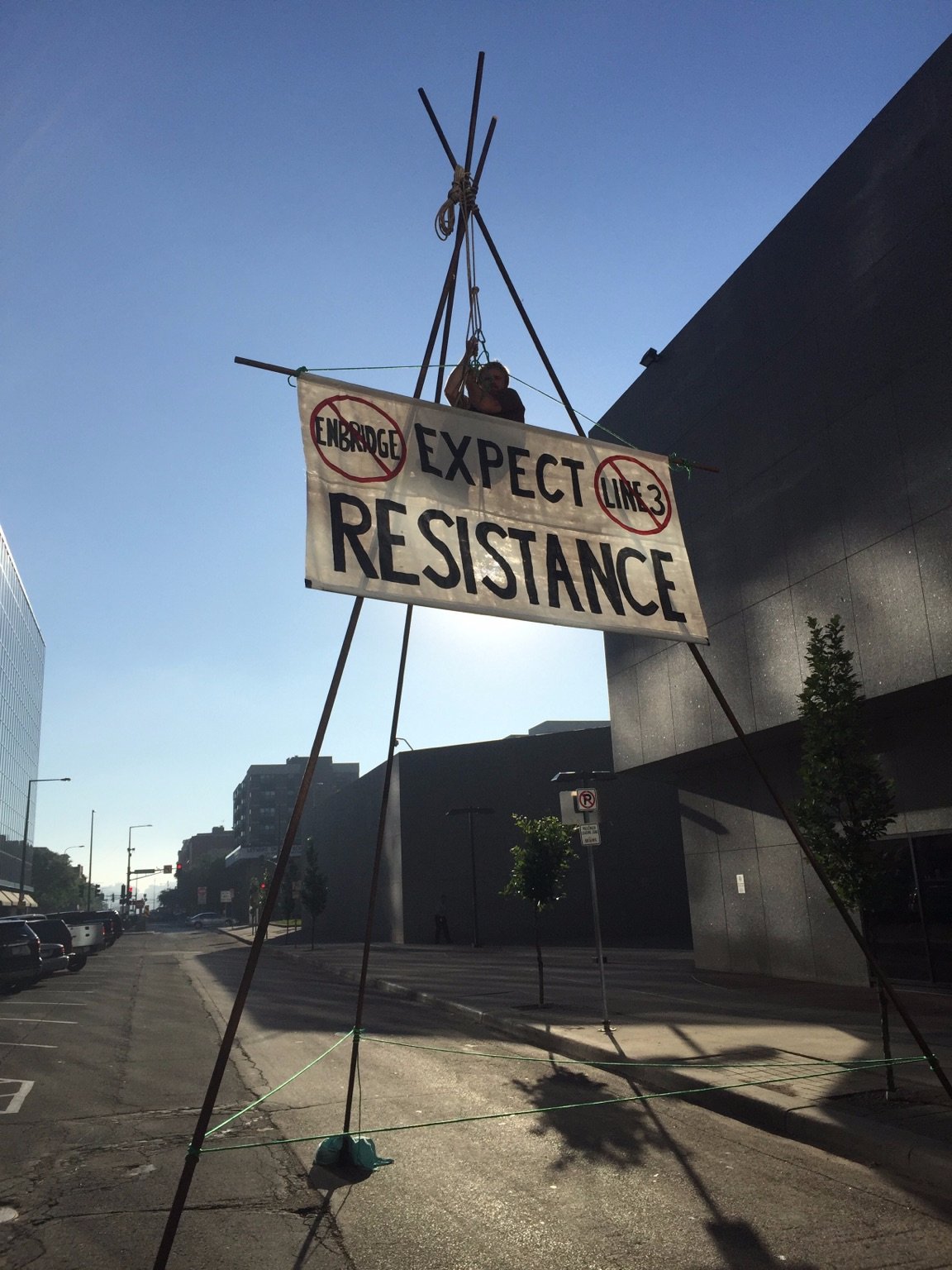
by DGR News Service | Jun 28, 2018 | Biodiversity & Habitat Destruction, Climate Change, Colonialism & Conquest, Indigenous Autonomy, Obstruction & Occupation
For Immediate Release
June 28, 2018
Activist risks arrest in front of Minnesota Public Utilities Commission Office during its final hearings to permit the Line 3 tar sands pipeline
Contact: Ethan Nuss, (218) 380-9047, stopline3mpls@gmail.com
ST PAUL, MN – A water protector ascended a 25-foot steel tripod structure erected in the street in front of the Public Utility Commission (PUC) office to demonstrate ongoing resistance against Enbridge’s proposed Line 3 tar sands pipeline. Today marks one of the final public hearings held by the PUC on its decision to grant a certificate of need to the controversial pipeline.
All five of the directly affected Objibwe Tribal Nations in Minnesota oppose the dangerous project because of the threat it poses to their fresh water, culturally significant wild rice lakes, and tribal sovereignty. Line 3 will accelerate climate change by bringing carbon-intensive tar sands bitumen from Alberta to refineries in the Midwest. Climate change disproportionately impacts Indigenous and frontline communities across the world. This deadly infrastructure project is another example of the genocidal legacy of colonialism faced by Native peoples and the ecological destruction caused by corporate greed. Water protectors, climate justice advocates, landowners, and faith leaders stand united alongside Native communities against this dangerous pipeline.
At around 7AM CST water protectors blockaded traffic by erecting 25-foot steel poles in a tripod structure on 7th Pl. in front of the PUC offices in downtown Saint Paul, MN. Ben, a 30-year-old Minneapolis resident, ascended the structure and unfurled a banner that reads, “Expect Resistance,” a clear message to Enbridge and the PUC that fierce opposition to this pipeline will continue to grow at every stage.
“If the PUC doesn’t stop Line 3, then we will,” said Ben, suspended from the 25-foot structure in the street in front the PUC. “Today’s action isn’t about me but is a demonstration of the growing resistance to Line 3. ” Ben continued, “We’re taking action in solidarity with Native people, who continue to fight for their existence on occupied land and with people all over the world who resist the desecration of nature by extractive industries.”
For photos and live updates go to: twitter.com/ResistLine3
(Update: the tripod was occupied for three years before being vacated)
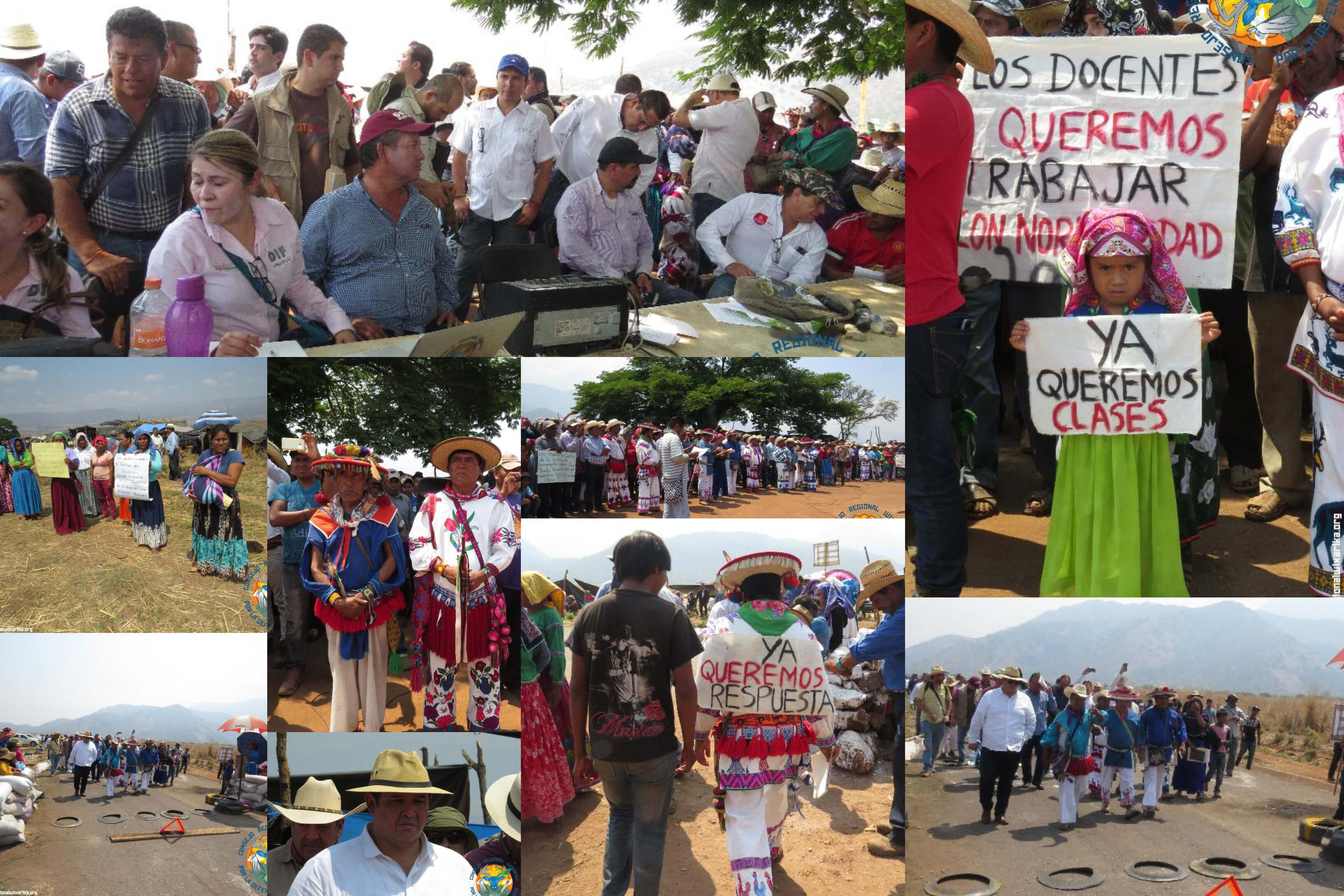
by Deep Green Resistance News Service | Jun 9, 2018 | Obstruction & Occupation
by Agustin del Castillo, Milenio Jalisco / Intercontinental Cry
Wixaritari communities of San Sebastián Teponahuaxtlán (Wuaut + a), have detained first and second level government officials from Jalisco State in the town of Mesa del Tirador, in protest of the lack of answers to their demands—in particular, the issue of land restitution in Huajimic, in the neighboring state of Nayarit. The state government officially denies that the officials are being ‘forcibly’ detained.
Sources from the state executive and from the community, confirmed to MILENIO JALISCO that there are several secretaries who are being held after attending a meeting the community called with them to discuss and resolve various problems relating to education, health, road infrastructure and poverty. Officials have been warned by the communal leaders that as a means of pressuring the officials to resolve these issues—but above all, due to the federal government’s neglect of the issue of land restitution—they will remain in Mesa del Tirador.
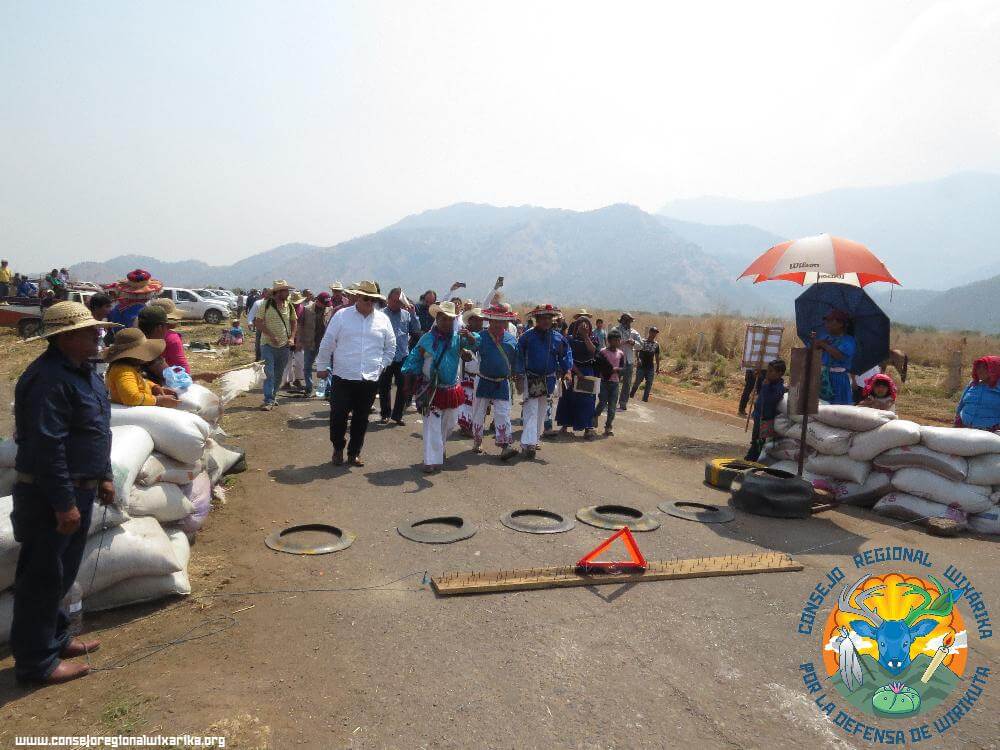
It was confirmed that the Secretary of Infrastructure and Public Works, Netzahualcóyotl Ornelas, is being detained at the meeting; as well as the Secretary of Education, Francisco Ayón López, and the Secretary of Development and Social Integration, Daviel Trujillo Cuevas; Lizana García, director of DIF Jalisco, and Mario Vladimir Avilés, director of agrarian affairs in the state; Mario Ramos Velasco, general director of the Secretariat of Rural Development (Seder); the municipal presidents of Bolaños, Juan Carlos Rodríguez Mayorga, and of Mezquitic, Misael de Haro.
Other retained officials include Andrés Palma Flores, delegate of the Ministry of the Interior; Rubén Ortega Lozano, director of the Human Rights Supervision Area, André Marx Miranda, director of CODE Jalisco; Ernesto Marroquín Álvarez, director of Support to Municipalities; Rogelio Azuara, delegate of the CDI Jalisco; Armando Pimentel Palomera, general director of Regions and Hospitals of the Ministry of Health.
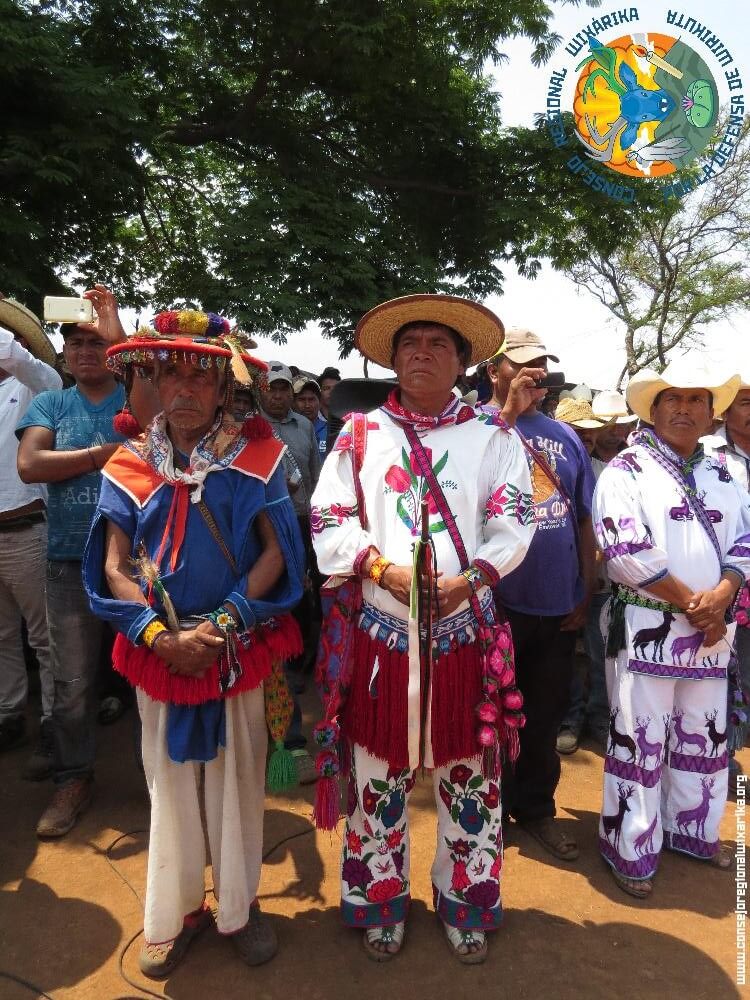
The demand is that the governor of the state, Aristóteles Sandoval Díaz, present himself to guarantee full compliance with all the lagged agreements.
“Mr. Vladimir stayed with us to advance the negotiations and bring us a proposal for a solution to the agrarian conflict, but he only informed us verbally, that he had met in Mexico and that the Ministry of Finance and Public Credit money to the Department of Agrarian, Territorial and Urban Development, to negotiate in ten days with the possessors, but just by word of mouth, did not deliver the promised agreement, did not give a check, and the assembly disagreed,” explained the spokesperson of the comuneros, Sofia Aukwe Mijarez.
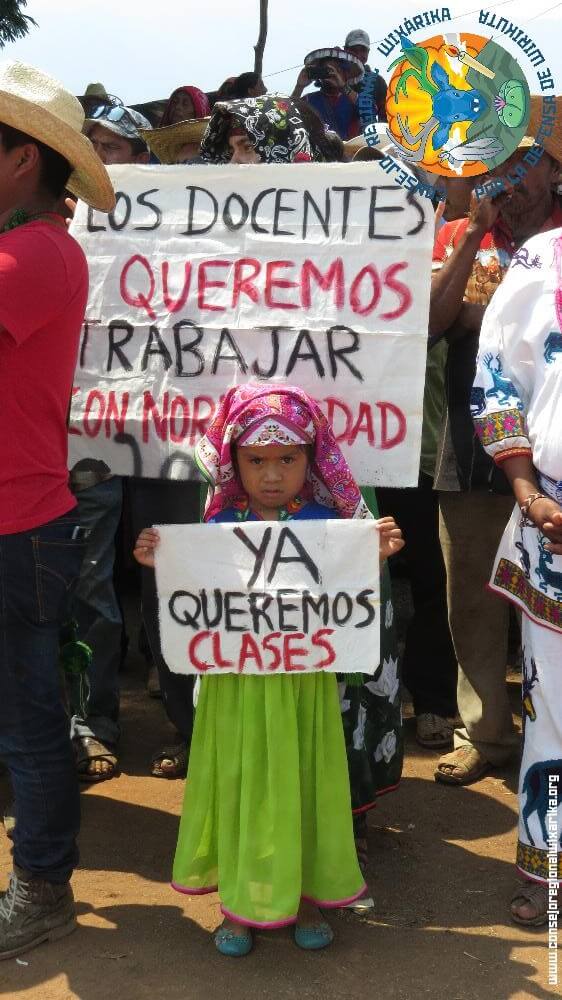
She clarified that there has been no threat or risk to the physical integrity of the officials, who remain working at work tables and that if the governor does not arrive at nightfall, “we have accommodation, food and blankets so that they are well protected.”
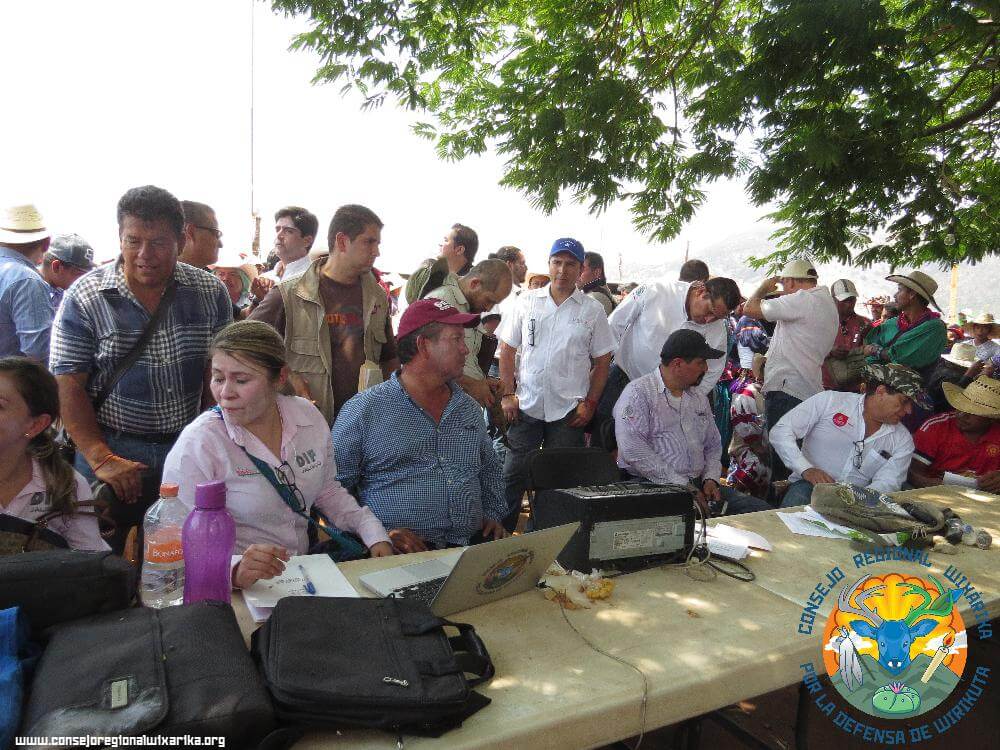
“DETENTION” DISMISSED BY STATE OFFICIALS
Interviewed by MILENIO JALISCO, the Secretary General of the State Government, Roberto López Lara, said that the officials are not being held against their will, and that they remain on the site because the work tables have not been concluded. The secretary acknowledges that there has been tension on some issues, but dismissed that state officials are forcibly detained.
López Lara explained that the points in which members of the Wixaritari community are dissatisfied are of federal order, especially due to the land dispute that exists between the indigenous people of the sierra, and community members of Nayarit, for which the state government acts as manager between the parties to expedite a solution to the conflict.
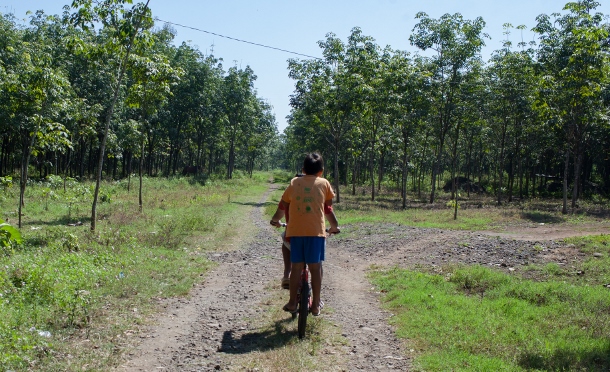
by Deep Green Resistance News Service | Jun 7, 2018 | NEWS, Reclamation & Expropriation
Featured image: Two children ride a bike through the plantation known as Las Palmeras in Guatemala. (WNV/Jeff Abbott)
by Jeff Abbott / Waging Nonviolence
Guatemala’s southern coast is in a constant conflict caused by the expansion of agro-industry. Across the region, small farmers struggle to feed their families as companies buy up more and more land for export crops.
Since the arrival of the Spanish to Guatemala in 1524, the country’s fertile southern coast has been the site of some of the most intense social conflicts over land. These conflicts have continued into the 21st century with the massive expansion of sugar cane and palm oil production.
Many of these land holdings have come to include illicit interests, including drug trafficking. But local small farmers, known as campesinos, have pushed back.
Since September 2016, 135 families associated with the Committee for Campesino Unity, also known by its Spanish acronym CUC, have maintained an occupation of a finca, or a large plantation, named Las Palmeras near the municipality of Cuyotenango. They are calling for the state to expropriate the land, which was once owned by a known drug trafficker, to the campesinos.
“We see the necessity [in our communities],” said Marcos (a pseudonym), a resident of the community of Progreso, who is supporting the occupation. “We have no place to work the land due to the amount of monoculture that surround us. They have made themselves the owners of the land. We have taken this finca because we need the land to sow the basic crops.”
The campesinos come from the surrounding departments of Quetzaltenango, Suchitepequez, and Retalhuleu.
The farmers have set up a small settlement on the finca, building small structures, as well as using the houses that are on the finca. They have established a collective store in the center of the finca, where they sell sodas, cooking oil and other common household items.
Since taking the finca, the campesinos have also begun to divide the land among the families. Many families have spent nearly two years sowing and harvesting several seasons of crops, including maize, beans, peanuts and fruits.
“They accuse us of land invasion,” said Francisco (a pseudonym), a campesino from a neighboring town who is supporting the occupation. “This is not an invasion, but rather a recuperation the lands of our ancestors.”
Organizing the occupations
Occupations have long been used in Guatemala by campesinos to gain titles to land. That practice grew dramatically in the 1950s following the passage of land reform under President Jacobo Arbenz. His administration expropriated unused land from large land holders, including the U.S.-based United Fruit Company, to be distributed among landless farmers across the country. After the U.S.-backed coup d’état in 1954, however, the tactic fell out of practice due to the threat of violence.
According to research by Charles D. Brockett, occupations would return to prominence in the late 1970s with the formation of the CUC. The organization was founded during the Guatemalan internal armed conflict and worked for the interests of the small farmers across Guatemala, as well as against structural inequalities and racism.
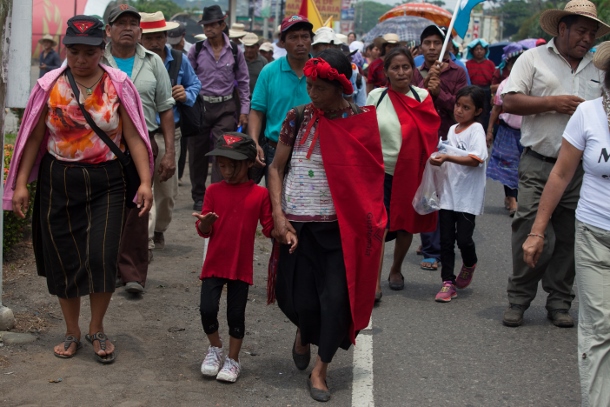
A woman wears a CUC flag while holding the hand of her daughter who wears a CUC hat during the 2016 water march. (WNV/Jeff Abbott)
Since the beginning of the 21st century, the region has seen the massive expansion of monocrops, such as sugar cane and bananas, for export by large landholders. This expansion of export crops further exacerbated the land crisis on the coast, driving many campesinos on the coast to organize to occupy the land due to the inequalities in land availability.
“The problem is that there is a lot of African palm oil, sugar cane, rubber and bananas being planted on the coast,” Marcos said. “These monocrops are leaving us without land to support our families. It was the necessity that drove us to take the finca. [The large land owners] have left us without any land.”
But the support from the CUC has been the key for the occupation on the Guatemalan coast, with the organization providing moral and legal support for the campesinos in Suchitepequez.
“After we launched the occupation, the CUC arrived to provide support,” Francisco said. “The CUC has worked for years to serve and support campesinos across Guatemala.”
The campesinos have also received support from other farmers who have participated in other occupations in the country. They sent others to support the occupation when it began.
“We had a meeting a few days [before the occupation] with other campesinos [that had participated in occupations],” Francisco said. “They saw the necessity of launching the occupation of the land. They decided on the date, where everyone came at 4 p.m. to occupy the land.”
Guatemala has a land problem that has dictated social relations from the Spanish invasion until today. A small percentage of the population controls the majority of arable lands that they utilize for the production of export crops for foreign markets such as sugar cane, African palm oil and bananas. This problem is being exacerbated by the rise of the influence of drug traffickers and criminal networks in the two decades since the end of the internal armed conflict in 1996.
Following the signing of the peace accords, the Guatemalan government established the Land Fund, which was meant to resolve the historic land problem. Yet the high price of the land often keeps it out of reach of landless farmers.
Narcos and land
Drug traffickers have increasingly taken to purchasing land as a means of laundering money, and as a means of transporting narcotics through Central America. As the country continues to work to fight drug trafficking in the country, campesinos have increasingly taken to occupying lands owned by convicted and accused drug traffickers, as well as lands owned by their associates.
The case of Finca Palmeras is a good example of this.
The finca was founded when the Ralda family purchased extensive land holdings in the department of Suchitepequez. Prior to the establishment of the finca, the land was largely used for rice production and cattle ranching.
When Manuel Ralda died, he divided the farm among his children, but his children chose to sell the land, including Finca Palmeras. In 1995, the lands of Finca Palmeras were transferred into the national land registry. Campesinos and others lined up to purchase the lands, but the price was outside the range made available by the Land Fund. The owners of the nine caballerias of land (or a little more than 850 acres) were set at 1.5 million quetzales per caballeria, or a little over 205,000 dollars.
“A group of campesinos entered that wanted to purchase the finca,” Francisco said. “But at the time, the Land Fund only provided credit for 1 million quetzales per caballeria. The fund would not provide the money to buy the land.”
Then entered Juan Alberto Ortiz Lopez — commonly known as Juan Chamale — who was one of the principal drug traffickers in Guatemala, and the main connection to the Mexican Sinaloa Cartel. He offered to buy the finca for 3 million quetzales per caballeria, and purchased the property. His goal was to create a front company to hide the transit of drugs from Colombia through the coastal region.
He quickly put in place security to block the local residents from passing through the finca to access the nearby Icán river, which was a popular fishing spot.
“Before we could fish in the rivers without any problem,” Francisco said. “But when Jaun Charmale bought the finca he put in place security guards, and it was prohibited to pass through the finca.”
According to the neighbors and campesinos occupying the finca, Charmale built new routes through the finca in order to move drugs. These routes connected to other fincas, eventually arriving at the Mexican border.
During the time that Ortiz Lopez owned the finca he would rent the lands to the neighboring fincas. This has caused problems for the campesinos occupying the land.
Furthermore, the campesino communities face an uphill battle to gain access to the land. The campesinos have faced intimidation and repression from the nearby fincas, including legal action over their occupation.
“We found ourselves with a problem,” Francisco said. “The neighboring fincas had sugar cane on part of the finca, and they filed a lawsuit against us in order to harvest that years’ crop.”
These lawsuits have included orders for the arrest of the organizers. The farmers also faced an eviction order that the police to date have not carried out.
Ortiz Lopez was finally arrested in 2011 on drug trafficking charges, and eventually extradited to the United States in 2014. At the time of his arrest, he was in possession of eight or nine fincas across Guatemala, which he would rent out to sugarcane producers, especially the nearby finca Palo Gordo. He had used the fincas as a means to launder his money from trafficking.
“The end of [Alvaro] Colom’s administration was when he finally fell,” Francisco said. “The government began to take the cattle that he had on the land.”
The campesinos are emboldened through the Law of Extinction of Domain, which was established in 2010. The law permits the expropriation of any assets of anyone convicted of a crime related to narco-trafficking, or any illicit crime.
Yet the campesinos’ claim is complicated. By the time he was arrested, Ortiz Lopez had put the titles for his land in his youngest son’s name. But campesinos from the region have laid claim to the lands, arguing that the Guatemalan government must apply the law, and expropriate the farm and distribute it among the small farmers.
Violence against occupying farmers
Despite the constant threat of eviction, the community has yet to see any violence. Meanwhile, other communities that have utilized the same law to argue for expropriating land have not been so lucky.
On October 30, 2017, the residents of the Q’eqchi’ Maya community of Chaab’il Ch’och were violently evicted from the homes they had occupied for a year. Police and military burned houses and crops, as well as the belongings of residents.
The community of Chaab’il Ch’och sits on a finca called Santa Isabel located in the municipality of Livingston, Ixabal. The finca was acquired by a shell company owned by former President Otto Pérez Molina.
The finca is currently being administered by Rodrigo Lainfiesta, a businessman and ally of Pérez Molina, who is also facing corruption charges. Pérez Molina is currently being prosecuted for corruption, as well as charges related to his association with drug traffickers.
In an interview for Upside Down World, one member of the occupation stated that they believed the land was used or going to be used for drug trafficking.
Yet, in spite of the violence against other communities, the campesinos in Suchitipequez are confident that they will emerge victorious.
“We are asking God that we will win, and believe we will,” Francisco said. “For our children, we do not want to see any more malnutrition in our communities.”
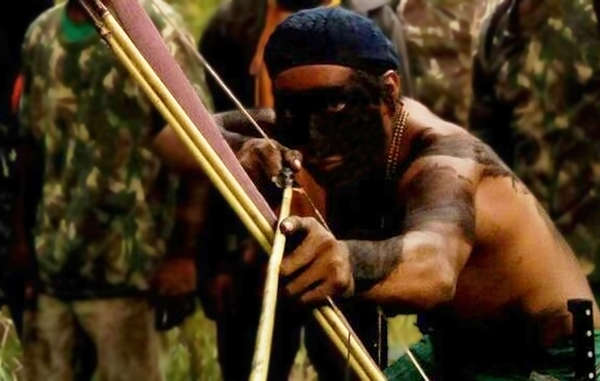
by Deep Green Resistance News Service | May 22, 2018 | Defensive Violence
Featured image: Guardians of the Amazon from the Guajajara tribe: “We patrol, we find the loggers, we destroy their equipment and we send them away. We’ve stopped many loggers. It’s working.” © Guardians of the Amazon
by Survival International
Members of an Amazon tribe patrolling their rainforest reserve to protect uncontacted relatives from illegal loggers have seized a notorious logging gang, burned their truck, and expelled them from the jungle.
The Guardians of the Amazon are from the Guajajara tribe: “We patrol, we find the loggers, we destroy their equipment and we send them away. We’ve stopped many loggers. It’s working.”
The area they are defending, Arariboia, is in the most threatened region in the entire Amazon. It is home to an uncontacted group of Awá Indians, a tribe well known for their affinity with animals and understanding of the forest, who face total annihilation if they come into contact with the loggers.
The Guardians have recently found abandoned Awá shelters close to where the loggers operate.
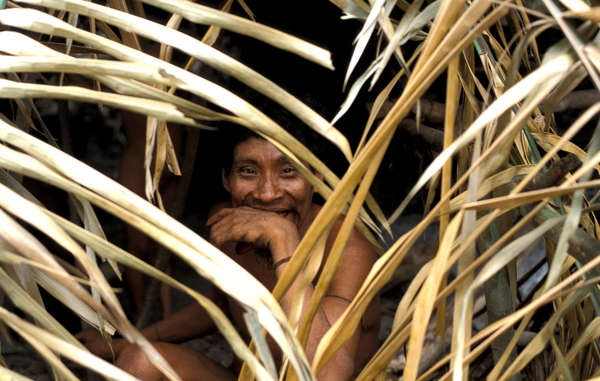
An Awá man called Takwarentxia, who was contacted in 1992 with his wife Hakõa’ĩ, and their baby. The rest of his family were killed by gunmen working for ranchers clearing the land. © Fiona Watson/Survival
They now fear violent retaliation. Three of the Guardians were murdered by loggers in 2016, and they have experienced arson attacks and regular death threats.
Burning Truck from Survival International on Vimeo.
The Guardians sent footage of the burning truck loaded with illegally cut timber to Survival International, along with the message: “Please show the world the reality we face. We know it’s risky and we have enemies but now’s no time for hiding. We want you to release this to the world so we can continue to protect our forest.”
Survival International has written urgently to the Brazilian government calling for the immediate and long term protection of both the Guardians themselves and of the area they fight to protect. Survival are also asking members of the public to send emails in support of the Guardians to government ministers via this page on their website.
Survival’s Director Stephen Corry said: “Tribal territories are the best barrier to deforestation, and these Guardians are defending the last patch of green amid a sea of destruction. It’s further proof that tribal peoples are the best conservationists and guardians of the natural world. The Guardians are virtually the only people standing between the loggers and the uncontacted Awá who still hold out in this forest. The Brazilian government’s inaction in the face of rampant illegal deforestation is shameful.”
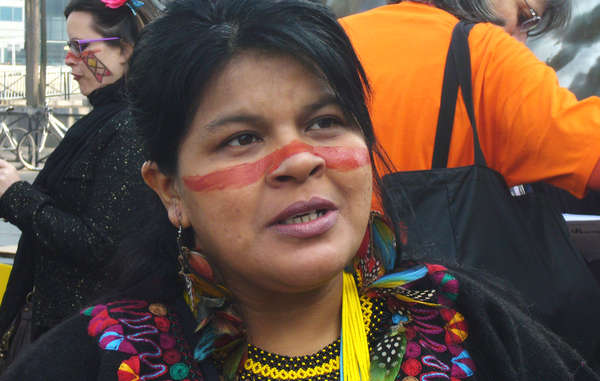
Sônia Guajajara at a protest in Paris against Brazil’s plans for a series of mega-dams in the Amazon, March 2014. © Survival International
She said today: “The Guardians’ work is both extremely valuable and incredibly risky. We indigenous peoples will never accept the ransacking of our Mother Earth – we listen to her and understand the way she talks to us because our life depends on her.”
BACKGROUND BRIEFING
The Guardians of the Amazon
– The “Guardians of the Amazon” are men from the Guajajara tribe in Brazil’s Maranhão state who have taken it upon themselves to protect what remains of this eastern edge of the Amazon rainforest.
– They want to save the land for the hundreds of Guajajara families who call it home, and their far less numerous neighbors: the uncontacted Awá Indians.
– The Guardians say of their work: “We patrol, we find the loggers, we destroy their equipment and we send them away. We’ve stopped many loggers. It’s working.”
– The Guardians recently released video and images of a rare encounter with the uncontacted Awá living in Arariboia. Watch the footage here
– You can see videos of several of the Guardians talking about their work on Survival’s Tribal Voice site.
Uncontacted tribes
– There are more than 100 uncontacted tribes worldwide. They have decided not to engage in regular contact with anyone from the outside world.
– They are not “lost” or trapped in a land that time forgot. They are aware of the outside world, and may engage sporadically with contacted tribes nearby.
– There’s irrefutable evidence that their tribal territories are the best barrier to deforestation, particularly in the Amazon rainforest.
– Uncontacted tribes are the most vulnerable peoples on the planet. Whole populations are wiped out by violence from outsiders who steal their land and resources, and by diseases like the flu and measles to which they have no resistance.
– It is not uncommon for 90% of the population to be wiped out following initial contact.
Awá
– The Awá are a hunter-gatherer people living in the forests of the eastern Brazilian Amazon
– While some Awá are in contact with the outside world, others are uncontacted.
– The Awá were known as “the most threatened tribe in the world” during a successful campaign by Survival International for the Brazilian government to expel the illegal loggers from one of their territories.
– The tribe are known for their affinity with the animals of their forest, and some families have more pets than people, from raccoon-like coatis to wild pigs and king vultures.
– Monkeys are the Awá’s favorites and individuals are often seen with their pet monkey riding on their head. Awá will rescue orphaned baby monkeys and adopt them as a member of the family, even breastfeeding them.
Arariboia
– The Arariboia indigenous territory comprises a unique biome in the transition area between the savannah and the Amazon rainforest.
– There are species here not found elsewhere in the Amazon.
– The land inside the indigenous territory is under threat from illegal loggers
– Brutal cuts in government funding to its indigenous affairs department FUNAI and tribal land protection mean the dangers are now even greater, as the area is not properly monitored or defended by the authorities.
– A powerful and violent logging mafia operates in the region, supported by some local politicians.

















